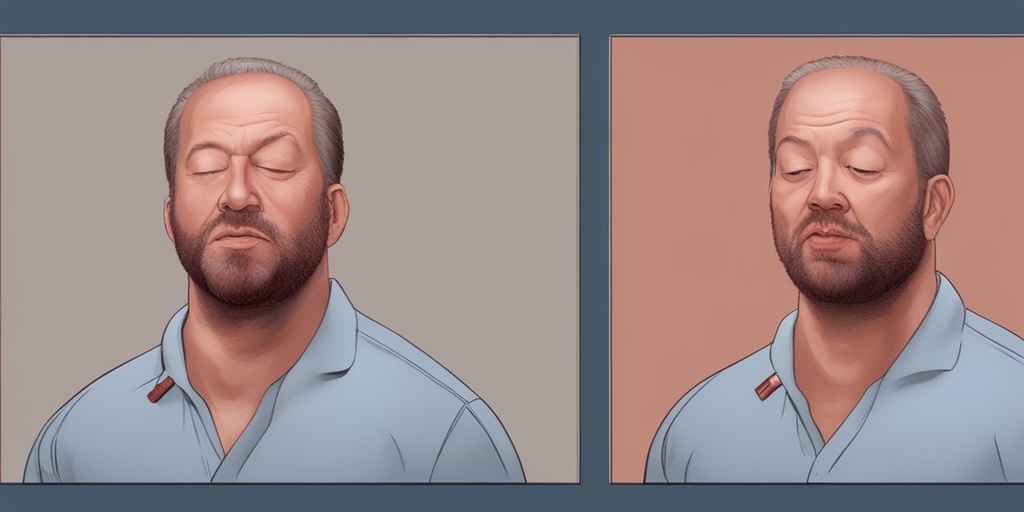What Is a Furrowed Tongue?
A furrowed tongue, also known as a grooved tongue or a tongue with furrows, is a condition where the tongue develops deep grooves or furrows on its surface. This can be a temporary or permanent condition, depending on the underlying cause. In this article, we’ll delve into the world of furrowed tongues, exploring what they are, their symptoms, causes, and possible treatments.
What Does a Furrowed Tongue Look Like?
A furrowed tongue typically appears with deep grooves or fissures on the surface of the tongue. These grooves can be shallow or deep, and may be accompanied by other symptoms such as redness, swelling, or pain. The tongue may also appear dry, cracked, or rough to the touch. In some cases, the furrows may be so deep that they resemble a series of small trenches or valleys on the tongue’s surface.
Furrowed Tongue Meaning
In some cultures, a furrowed tongue is believed to be a sign of poor health or dehydration. However, this is not always the case. A furrowed tongue can be caused by a variety of factors, including genetics, nutritional deficiencies, and certain medical conditions. In some cases, a furrowed tongue may be a symptom of an underlying health issue, such as Down syndrome or Sjögren’s syndrome.
Furrowed Tongue Symptoms
In addition to the visible grooves or furrows on the tongue, a furrowed tongue may be accompanied by other symptoms, including:
- Dry mouth: A feeling of dryness or stickiness in the mouth, which can make it difficult to speak or eat.
- Tongue pain: Pain or discomfort on the tongue, which can be mild or severe.
- Redness and swelling: The tongue may appear red, swollen, or inflamed, which can be uncomfortable and painful.
- Difficulty speaking: The grooves on the tongue can make it difficult to pronounce certain words or speak clearly.
- Bad breath: A furrowed tongue can trap bacteria and food particles, leading to bad breath or halitosis.
If you’re experiencing any of these symptoms, it’s essential to consult with a healthcare professional to determine the underlying cause and appropriate treatment.
Stay tuned for the next part of this article, where we’ll explore the causes of a furrowed tongue and possible treatment options. In the meantime, if you have any questions or concerns about your health, consider consulting with Yesil Health AI (yesilhealth.com) for evidence-based health answers. 🤔

Causes of a Furrowed Tongue
A furrowed tongue, also known as a grooved or fissured tongue, is a condition characterized by deep grooves or furrows on the surface of the tongue. While it may seem like a harmless condition, a furrowed tongue can be a sign of an underlying health issue. So, what causes a furrowed tongue?
Dehydration
One of the most common causes of a furrowed tongue is dehydration. When your body lacks sufficient water, your tongue can become dry and shrivel up, leading to the formation of grooves and furrows. This is especially common in people who don’t drink enough water or have a medical condition that affects their ability to regulate fluids.
Down Syndrome
People with Down syndrome are more likely to develop a furrowed tongue due to their genetic condition. The exact reason for this is still unknown, but it’s thought to be related to the abnormal development of the tongue and mouth tissues.
Oral Health Issues
Oral health issues such as gum disease, tooth decay, and mouth ulcers can also contribute to a furrowed tongue. When your mouth is unhealthy, your tongue can become inflamed and develop grooves as a result.
Nutritional Deficiencies
Lack of essential nutrients like vitamin B12, iron, and zinc can affect the health of your tongue, leading to the formation of furrows. This is because these nutrients play a crucial role in the development and maintenance of healthy tongue tissues.
Systemic Diseases
Certain systemic diseases like diabetes, anemia, and thyroid disorders can cause a furrowed tongue. This is because these conditions can affect the body’s ability to regulate fluids, leading to dehydration and tongue dryness.
Risk Factors for Developing a Furrowed Tongue
While anyone can develop a furrowed tongue, some people are more at risk than others. Here are some risk factors to be aware of:
Age
Older adults are more likely to develop a furrowed tongue due to the natural aging process, which can lead to dry mouth and tongue dryness.
Genetics
If you have a family history of furrowed tongue or other oral health issues, you may be more at risk of developing the condition.
Poor Oral Hygiene
Failing to practice good oral hygiene habits like regular brushing and flossing can increase your risk of developing a furrowed tongue.
Smoking
Smoking can dry out your mouth and tongue, increasing your risk of developing a furrowed tongue. 💦
Medications
Certain medications like antidepressants, antihistamines, and painkillers can cause dry mouth, which can lead to a furrowed tongue.
By understanding the causes and risk factors of a furrowed tongue, you can take steps to prevent or manage the condition. Remember to stay hydrated, practice good oral hygiene, and seek medical attention if you notice any unusual changes in your tongue. 👍

How to Diagnose a Furrowed Tongue
A furrowed tongue, also known as a grooved tongue or a tongue with furrows, is a condition where the tongue develops deep grooves or furrows on its surface. This condition can be a sign of an underlying health issue, and it’s essential to diagnose it correctly to determine the best course of treatment. In this section, we’ll explore how to diagnose a furrowed tongue.
Visual Examination
The first step in diagnosing a furrowed tongue is a visual examination. A healthcare professional will typically examine the tongue to look for any visible signs of furrows or grooves. They may use a tongue depressor to gently press down on the tongue and get a better view of the surface.
Medical History
A thorough medical history is also essential in diagnosing a furrowed tongue. The healthcare professional will ask questions about the patient’s medical history, including any underlying health conditions, medications, and symptoms. This information can help identify potential causes of the furrowed tongue.
Physical Examination
A physical examination may also be necessary to rule out any underlying health conditions that could be contributing to the furrowed tongue. The healthcare professional may check for signs of dehydration, such as dry mouth, dark urine, and decreased skin elasticity.
Diagnostic Tests
In some cases, diagnostic tests may be necessary to confirm the diagnosis of a furrowed tongue. These tests may include:
- Blood tests: To check for underlying health conditions, such as anemia or nutritional deficiencies.
- Imaging tests: Such as X-rays or CT scans to rule out any underlying structural abnormalities.
- Oral swabs: To check for any infections or inflammation in the mouth.
Treatment Options for a Furrowed Tongue
Treatment for a furrowed tongue depends on the underlying cause of the condition. In this section, we’ll explore some of the common treatment options for a furrowed tongue.
Treating Underlying Health Conditions
If the furrowed tongue is caused by an underlying health condition, such as dehydration or anemia, treating the underlying condition can help resolve the furrowed tongue. This may involve:
- Increasing fluid intake: To treat dehydration and prevent dry mouth.
- Taking nutritional supplements: To address any nutritional deficiencies.
- Managing underlying health conditions: Such as diabetes or thyroid disorders.
Good Oral Hygiene
Good oral hygiene practices can help reduce the appearance of a furrowed tongue. This includes:
- Brushing the tongue: Gently brushing the tongue with a soft-bristled toothbrush can help remove bacteria and debris.
- Flossing: Flossing can help remove food particles and plaque from between the teeth and under the gumline.
- Rinsing with mouthwash: Rinsing with an antibacterial mouthwash can help kill bacteria and freshen the mouth.
Topical Treatments
In some cases, topical treatments may be necessary to reduce the appearance of a furrowed tongue. These may include:
- Tongue scrapers: Using a tongue scraper to remove bacteria and debris from the surface of the tongue.
- Antibacterial creams: Applying antibacterial creams or ointments to the tongue to reduce bacterial growth.
Remember, if you’re experiencing a furrowed tongue, it’s essential to consult with a healthcare professional to determine the underlying cause and develop an appropriate treatment plan. 💊

Home Remedies for a Furrowed Tongue
A furrowed tongue, also known as a grooved or fissured tongue, can be an unsightly and uncomfortable condition. While it’s often a harmless symptom, it can be a sign of an underlying issue. Fortunately, there are several home remedies that can help alleviate the symptoms and improve the appearance of your tongue.
Stay Hydrated 💧
Dehydration is a common cause of a furrowed tongue. When your body lacks sufficient water, your tongue can become dry and develop deep grooves. Drinking plenty of water can help to rehydrate your tongue and reduce the appearance of furrows. Aim to drink at least eight glasses of water a day, and avoid sugary drinks that can exacerbate dehydration.
Maintain Good Oral Hygiene 🚽
Practicing good oral hygiene can help to reduce the buildup of bacteria and fungi on your tongue, which can contribute to a furrowed tongue. Brush your teeth and tongue regularly with a soft-bristled toothbrush and a fluoride toothpaste. You can also use a tongue scraper to remove bacteria and debris from the surface of your tongue.
Use a Saltwater Rinse 💦
A saltwater rinse can help to reduce inflammation and kill bacteria on your tongue. Mix one teaspoon of salt with eight ounces of warm water and swish the solution around your mouth for 30 seconds before spitting it out. Repeat this process several times a day to help reduce the appearance of furrows.
Try a Tongue Massage 💆♀️
Massaging your tongue can help to increase blood flow and reduce tension, which can contribute to a furrowed tongue. Use your fingers to gently massage your tongue in a circular motion, focusing on the areas with deep grooves. Repeat this process several times a day to help improve the appearance of your tongue.
When to See a Doctor for a Furrowed Tongue
While a furrowed tongue is often a harmless condition, it can be a sign of an underlying issue that requires medical attention. If you experience any of the following symptoms, you should see a doctor:
Persistent Pain or Discomfort 🤕
If you experience persistent pain or discomfort on your tongue, it could be a sign of an underlying infection or inflammation. Your doctor can help to diagnose the cause of your symptoms and recommend appropriate treatment.
Difficulty Eating or Speaking 🍴
If your furrowed tongue is making it difficult to eat or speak, you should see a doctor. Your doctor can help to identify the underlying cause of your symptoms and recommend treatment to improve your quality of life.
Other Symptoms 🤒
If you experience other symptoms such as fever, swelling, or bleeding on your tongue, you should see a doctor. These symptoms can be a sign of an underlying infection or condition that requires medical attention.
Remember, if you’re concerned about your furrowed tongue or if it’s accompanied by other symptoms, it’s always best to consult with a healthcare professional for proper diagnosis and treatment. 💊

Furrowed Tongue: Frequently Asked Questions
What is a Furrowed Tongue?
A furrowed tongue is a condition where the tongue has deep grooves or furrows on its surface. It can be a temporary or permanent condition, and it may be accompanied by other symptoms such as dry mouth, soreness, or difficulty speaking.
What Causes a Furrowed Tongue?
The exact cause of a furrowed tongue is not always clear, but it can be related to various factors such as:
- Dehydration: Not drinking enough water can cause the tongue to become dry and develop furrows.
- Down Syndrome: People with Down syndrome are more likely to have a furrowed tongue due to their genetic condition.
- Other medical conditions: Certain medical conditions, such as diabetes, anemia, or vitamin deficiencies, can cause a furrowed tongue.
- Hormonal changes: Hormonal fluctuations during pregnancy, menopause, or thyroid disorders can lead to a furrowed tongue.
How to Treat a Furrowed Tongue?
Treating a furrowed tongue usually involves addressing the underlying cause. Here are some general tips:
- Stay hydrated: Drink plenty of water to keep your tongue and mouth moist.
- Maintain good oral hygiene: Brush your teeth and tongue regularly to remove bacteria and debris.
- Avoid irritants: Avoid consuming spicy, acidic, or sharp foods that can irritate your tongue.
- Manage underlying conditions: If you have a medical condition, work with your healthcare provider to manage it effectively.
Is a Furrowed Tongue a Sign of Dehydration?
Yes, a furrowed tongue can be a sign of dehydration. When your body is dehydrated, your tongue can become dry and develop furrows. Drinking plenty of water can help to rehydrate your body and reduce the appearance of a furrowed tongue.
Can a Furrowed Tongue be a Sign of a More Serious Condition?
In some cases, a furrowed tongue can be a sign of a more serious underlying condition, such as diabetes, anemia, or vitamin deficiencies. If you notice a furrowed tongue along with other symptoms, it’s essential to consult with your healthcare provider to rule out any underlying conditions.
How to Pronounce Furrowed Tongue?
The pronunciation of “furrowed tongue” is /ˈfʊroʊd ˈtʌŋ/ (FUR-ohd TUNG).
What are the Images of a Furrowed Tongue?
You can find images of a furrowed tongue online, which can help you identify the condition. However, it’s essential to consult with a healthcare professional for an accurate diagnosis and treatment plan.
What is the Meaning of Furrowed Tongue in Hindi, Tamil, and Kannada?
The meaning of “furrowed tongue” in Hindi is फुरोव्ड टंग (furōvḍ ṭaṅg), in Tamil is ஃபுரோவ்ட் டங் (furōvṭ ṭaṅ), and in Kannada is ಫುರೋವ್ಡ್ ಟಂಗ್ (furōvḍ ṭaṅg).




